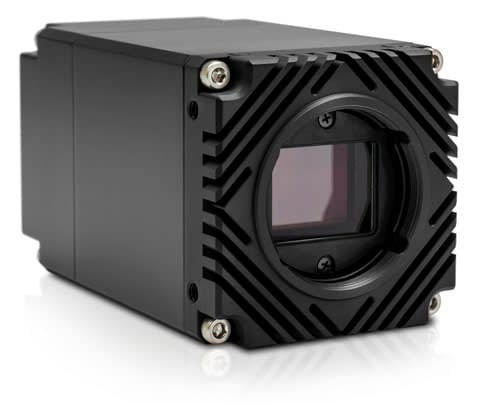Sony 4th Generation "Pregius S": The Next Evolution of Image Sensors?
With a smaller pixel size combined with backside illuminated technology, Sony was able to increase resolutions within compact sensor sizes without sacrificing imaging quality with their 4th generation Pregius sensors – named “Pregius S”. But do these latest sensors mean you should disregard previous generations? Take a deep dive and discover the strengths that each generation has to offer.
In the Beginning...
In 2013, Sony released their first Pregius™ CMOS sensor, the 2.3 MP IMX174. Before the release, CCD sensors were the market leaders with higher resolutions, superior image quality, and global shutter readout. CMOS sensors, while offering lower prices and higher frame rates, suffered from poorer imaging performance and offered only rolling shutter readout. The release of the IMX174 changed all of this. The IMX174 CMOS sensor ushered in not only better image quality with higher quantum efficiency, higher dynamic range, and lower read noise but it also offered global shutter readout and a higher frame rate output compared to equivalent CCDs at the time. With the continued addition of more global shutter Pregius sensors, now spanning across 4 generations, users have a wide selection of sensors to choose from.
Table of Contents
Sony 4th Generation “Pregius S”: Backside Illuminated (BSI)
Resolutions: High Speed and Standard Speed
Balancing Act: Pixel Size & Image Quality
Sensor Sizes & Aspect Ratios
Sensor Features: New and Always Improving
Maximizing Pregius Performance for the User
Something for Everyone
There are now 4 generations of Sony Pregius CMOS sensors, with the 4th generation being branded “Pregius S”. While each generation offers improvements from the previous one, certain features from older generations can still outperform later ones. Depending on what type of resolution, frame rate, image quality performance, or sensor feature you’re looking for, will dictate which generation is the most appropriate.
Triton Models with 4th Gen Pregius S sensors:
| Models | MP | Resolution | Fake FPS | FPS | Sensor | Format | Pixel Size | Shutter | Lens Mount | Chroma | Interface |
|---|---|---|---|---|---|---|---|---|---|---|---|
| TRI245S | 24.5 MP | 5320 x 4600 px | 1 | 4.9 fps | Sony IMX540 CMOS | 4/3" | 2.74 µm | Global | C | Mono / Color | M12 GigE Vision |
| TRI204S | 20.4 MP | 4510 x 4510 px | 2 | 6 fps | Sony IMX541 CMOS | 1.1" | 2.74 µm | Global | C | Mono / Color | M12 GigE Vision |
| TRI162S | 16.2 MP | 5320 x 3040 px | 4 | 7.5 fps | Sony IMX542 CMOS | 1.1" | 2.74 µm | Global | C | Mono / Color | M12 GigE Vision |
| TRI124S | 12.3MP | 4096 x 3000 px | 5 | 9.5 fps | Sony IMX545 CMOS | 1/1.1" | 2.74 µm | Global | C | Mono / Color | M12 GigE Vision |
| TRI081S | 8.1 MP | 2840 x 2840 px | 6 | 14.8 fps | Sony IMX546 CMOS | 2/3″ | 2.74 µm | Global | C | Mono / Color | M12 GigE Vision |
| TRI051S | 5.0 MP | 2448 x 2048 px | 7 | 24 fps | Sony IMX547 CMOS | 1/1.8″ | 2.74 µm | Global | C | Mono / Color | M12 GigE Vision |
Triton2 2.5GigE Models with 4th Gen Pregius S sensors:
| Model | MP | Resolution | FPS | Sensor | Format | Pixel Size | Shutter | Lens Mount | Chroma | Interface |
|---|---|---|---|---|---|---|---|---|---|---|
| TRT245S | 24.5 MP | 5320 x 4600 px | 11.3 fps | Sony IMX540 CMOS | 1.2" | 2.74 µm | Global | C | Mono / Color | 2.5GigE M12 |
| TRT204S | 20.4 MP | 4504 x 4504 px | 13.5 fps | Sony IMX541 CMOS | 1.1" | 2.74 µm | Global | C | Mono / Color | 2.5GigE M12 |
| TRT162S | 16.2 MP | 5320 x 3040 px | 17.5 fps | Sony IMX542 CMOS | 1.1" | 2.74 µm | Global | C | Mono / Color | 2.5GigE M12 |
| TRT124S | 12.3 MP | 4096 x 3000 px | 21.7 fps | Sony IMX545 CMOS | 1/1.1" | 2.74 µm | Global | C | Mono / Color | 2.5GigE M12 |
| TRT081S | 8.1 MP | 2840 x 2840 px | 31.8 fps | Sony IMX546 CMOS | 2/3″ | 2.74 µm | Global | C | Mono / Color | 2.5GigE M12 |
| TRT051S | 5.0 MP | 2448 x 2048 px | 49.2 fps | Sony IMX547 CMOS | 1/1.8″ | 2.74 µm | Global | C | Mono / Color | 2.5GigE M12 |
Atlas IP67 5GigE Models with 4th Gen Pregius S sensors:
| Models | MP | Resolution | Fake FPS | FPS | Sensor | Format | Pixel Size | Shutter | Lens Mount | Chroma | GigE Vision Interface |
|---|---|---|---|---|---|---|---|---|---|---|---|
| ATP245S | 24.5 MP | 5320 x 4600 px | 1 | 22.7 fps | Sony IMX540 CMOS | 4/3" | 2.74 µm | Global | C-mount | Mono / Color | 5GBASE-T, M12 |
| ATP204S | 20.4 MP | 4504 x 4504 px | 2 | 27.3 fps | Sony IMX541 CMOS | 1.1" | 2.74 µm | Global | C-mount | Mono / Color | 5GBASE-T, M12 |
| ATP162S | 16.2 MP | 5320 x 3032 px | 4 | 34.4 fps | Sony IMX542 CMOS | 1.1" | 2.74 µm | Global | C-mount | Mono / Color | 5GBASE-T, M12 |
| ATP124S | 12.3 MP | 4096 x 3000 px | 5 | 42.5 fps | Sony IMX545 CMOS | 1/1.1" | 2.74 µm | Global | C-mount | Mono / Color | 5GBASE-T, M12 |
| ATP081S | 8.1 MP | 2840 x 2840 px | 8 | 68.8 fps | Sony IMX546 CMOS | 2/3″ | 2.74 µm | Global | C-mount | Mono / Color | 5GBASE-T, M12 |
| ATP051S | 5.0 MP | 2448 x 2048 px | 10 | 110 fps | Sony IMX547 CMOS | 1/1.8″ | 2.74 µm | Global | C-mount | Mono / Color | 5GBASE-T, M12 |
Atlas10 10GigE Models with 4th Gen Pregius S sensors:
| Model | MP | Resolution | FPS | Sensor | Format | Pixel Size | Shutter | Lens Mount | Chroma | Interface |
|---|---|---|---|---|---|---|---|---|---|---|
| ATX245S | 24.5 MP | 5320 x 4600 px | 45.4 fps | Sony IMX530 CMOS | 1.2" | 2.74 µm | Global | TFL / C-Mount | Mono / Color | 10GBASE-T, M12 |
| ATX204S | 20.4 MP | 4504 x 4504 px | 54.1 fps | Sony IMX531 CMOS | 1.1" | 2.74 µm | Global | C-Mount | Mono / Color | 10GBASE-T, M12 |
| ATX162S | 16.2 MP | 5320 x 3032 px | 76.1 fps | Sony IMX532 CMOS | 1.1" | 2.74 µm | Global | C-Mount | Mono / Color | 10GBASE-T, M12 |
| ATX124S | 12.3 MP | 4096 x 3000 px | 89.7 fps | Sony IMX535 CMOS | 1/1.1″ | 2.74 µm | Global | C-Mount | Mono / Color | 10GBASE-T, M12 |
| ATX081S | 8.1 MP | 2840 x 2840 px | 136.7 fps | Sony IMX536 CMOS | 2/3″ | 2.74 µm | Global | C-Mount | Mono / Color | 10GBASE-T, M12 |
| ATX051S | 5.0 MP | 2448 x 2048 px | 205 fps | Sony IMX537 CMOS | 1/1.8 | 2.74 µm | Global | C-Mount | Mono / Color | 10GBASE-T, M12 |
Sony 4th Generation "Pregius S": Backside Illuminated (BSI)
Wider Incident Angle = Better Light Sensitivity
Even with a smaller pixel size, 4th generation Pregius S sensors maintain comparable sensitivity thanks in part to improved lowered incident angle performance. For example, at +/-20°, 2nd generation sensors receive just 10% of the light coming to the pixel, but 4th generation sensors receive 40%. This is because the distance between the microlens and the photodiode surface is much closer for 4th generation sensors.
Resolutions: High Speed and Standard Speed
The very first generation included only 1 resolution – 1936 x 1216 (2.3MP). This resolution however was available in two frame rate variations: high speed and standard speed. The high speed IMX174 ran at a maximum frame rate of 166 FPS while the standard speed IMX249 ran at a reduced 41 FPS. For a reduced price, the standard speed variations would limit maximum frame rates and restrict ADC, binning, and ROI options while maintaining the same image quality performance as the high speed variations. Sony would continue this trend of offering high speed and standard speed variations as future generations and models were released.
The lists and plot chart below illustrated the overall Pregius landscape regarding megapixel and frame rate sensor models. Each generation has various models, each with a different resolution and frame rate. While a few models from different generations overlap one another, a deeper dive into each generation’s pixel technology will help differentiate why certain models overlap.
Generation 1
| High Speed | Standard Speed |
|---|---|
| IMX174 (2.3MP @ 166 FPS) | IMX249 (2.3MP @ 41 FPS) |
* Note: the maximum frame rates presented on these charts are based on Sony’s listed maximum frame rate specification for the sensor. For most high speed versions, the maximum frame rate is based on 8-bit mode. Standard speed maximum frame rates are based on 10-bit or 12-bit mode. Maximum frame rates will vary based on bit depth, camera manufacturer, interface bandwidth, and number of cameras connected to the host PC.
Generation 2
| High Speed | Standard Speed |
|---|---|
| IMX342 (31.4MP @ 35 FPS) | |
| IMX367 (19.6MP @ 43 FPS) | |
| IMX387 (16.9MP @ 61 FPS) | |
| IMX253 (12.3MP @ 68 FPS) | IMX304 (12.3MP @ 23 FPS) |
| IMX255 (8.9MP @ 94 FPS) | IMX267 (8.9MP @ 32 FPS) |
| IMX250 (5.0MP @ 163 FPS) | IMX264 (5.0MP @ 36 FPS) |
| IMX252 (3.2MP @ 216 FPS) | IMX265 (3.2MP @ 56 FPS) |
| IMX392 (2.3MP @ 200 FPS) | |
| IMX273 (1.6MP @ 276 FPS) | IMX296 (1.6MP @ 60 FPS) |
| IMX287 (0.4MP @ 523 FPS) | IMX297 (0.4MP @ 121 FPS) |
Generation 3
| High Speed | Standard Speed |
|---|---|
| IMX420 (7.1MP @ 207 FPS) | IMX428 (7.1MP @ 35 FPS) |
| IMX421 (2.8MP @ 409 FPS) | IMX429 (2.8MP @ 43 FPS) |
| IMX422 (2.0MP @ 477 FPS) | IMX430 (2.0MP @ 132 FPS) |
| IMX425 (1.7MP @ 662 FPS) | IMX432 (1.7MP @ 98 FPS) |
Generation 4
| High Speed | Standard Speed |
|---|---|
| IMX530 (24.5MP @ 106 FPS) | IMX540 (24.5MP @ 35 FPS) |
| IMX531 (20.4MP @ 109 FPS) | IMX541 (20.4MP @ 42 FPS) |
| IMX532 (16.2MP @ 159 FPS) | IMX542 (16.2MP @ 52 FPS) |
| IMX535 (12.4MP @ 184 FPS) | IMX545 (12.4MP @ 68 FPS) |
| IMX536 (8.1MP @ 194 FPS) | IMX546 (8.1MP @ 91 FPS) |
| IMX537 (5.1MP @ 259 FPS) | IMX547 (5.1MP @ 122 FPS) |
Sony Pregius Generations – Megapixels vs Max Frame Rate Plot Chart
Hover mouse over plots for sensor details
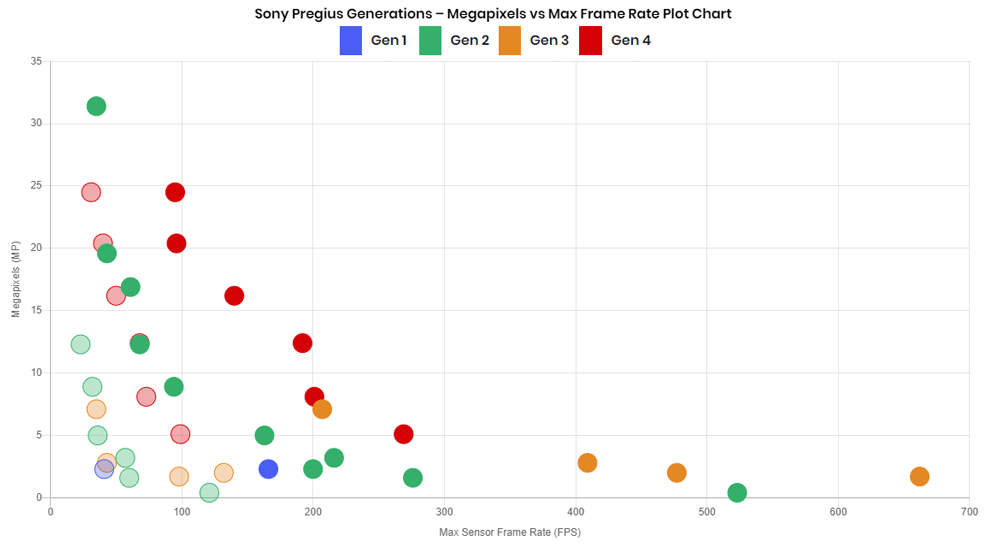
Balancing Act: Pixel Size & Image Quality
Much of the difference between generations is attributed to pixel size and pixel technology. For each generation, the pixel size is different; 1st generation is 5.86 µm; 2nd generation is 3.45 µm; 3rd generation is 4.5 µm; and 4th generation is 2.74µm. The pixel size will not only determine how many pixels can fit into a specific sensor size, but it will also result in different image quality performance characteristics. Each generation has a unique saturation capacity, temporal read noise, dynamic range and quantum efficiency. In general, the larger the pixel size, the higher the saturation capacity and temporal dark noise. For example, 1st generation sensors have the highest saturation capacity average of 33000e- but also have the highest temporal dark noise of 7e-. Contrast that to 4th generation sensors which have the smallest pixel size and therefore the lowest saturation capacity average of 9500e- and the lowest temporal dark noise of 2.1e-. This proportional relationship between saturation capacity and dark noise is what allows the Pregius sensors to maintain a similar dynamic range of around 70db across the generations even though their pixel sizes are different.
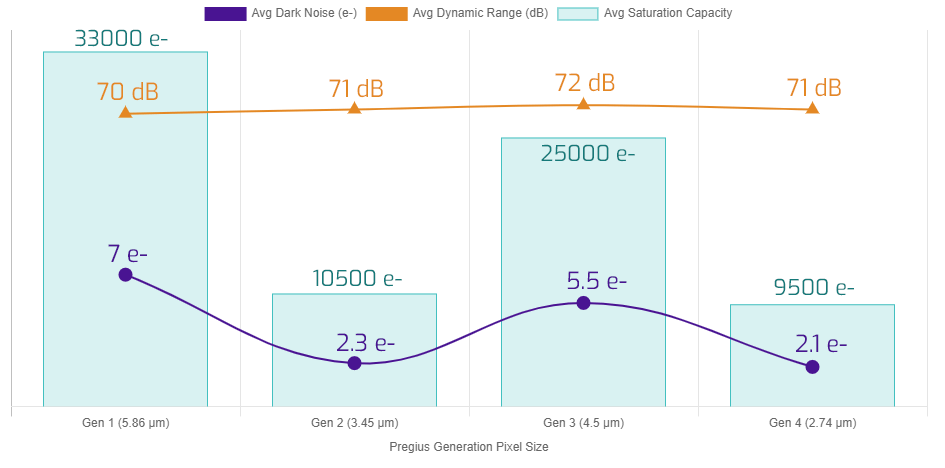
Comparing Average EMVA1288 Results Against Pixel Size
Hover mouse over plots for details.
| Pregius Generation Pixel Size |
Avg Saturation Capacity |
Saturation Capacity (e-/µm^2) |
Avg Read Noise |
Avg Dynamic Range |
|---|---|---|---|---|
| 1st Gen: 5.86µm | 33000 e- | 961 | 7 e- | 70 dB |
| 2nd Gen: 3.45µm | 10500 e- | 882 | 2.3 e- | 71 dB |
| 3rd Gen: 4.5µm | 25000 e- | 1235 | 5.5 e- | 72 dB |
| 4th Gen: 2.74µm | 9500 e- | 1265 | 2.1 e- | 71 dB |
Comparing the quantum efficiency (QE) average of the 4 generations shows some major differences between them. 1st generation Pregius sensors show high peak QE within the 480 to 540nm range. The 2nd generation had lower peak QE but shifted efficiency improvements from 600nm and onward. The 3rd generation brought peak QE back closer to 1st generation results, greatly improving efficiency over the entire range and attaining the best near infrared (700nm to 900nm) performance. 4th generation sensors share similar peak QE performance with 1st generation sensors while offering middle ground performance between 1st and 3rd generation for the rest of the curve. The QE graph highlights each generation’s unique efficiency curve and illustrates that later generations do not necessarily have outright performance gains.
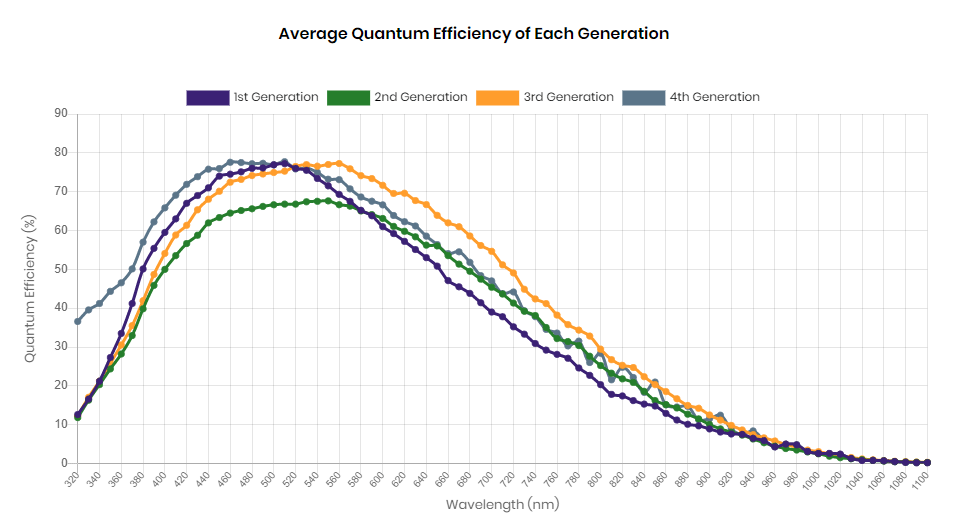
Average Quantum Efficiency of Each Generation
Hover mouse over plots for details. Click legend to turn off/on curves.
Note: The results shown in the QE comparison chart are based on EMVA 1288 testing of industrial camera models with sensor cover glass.
Sensor Sizes & Aspect Ratios
A key benefit of smaller pixel sizes is being able to offer more pixels in a given sensor size. This allows industrial cameras to remain compact and utilize more compact optics such as C-mount, NF, or S-mount lenses. For example, the maximum megapixels offered in a Type 1.1″ sensor size grows higher as pixel size decreases: 3rd generation (4.5µm) sensor is 7.1 MP, 2nd generation (3.45µm) is 12.3 MP, and 4th generation (2.74µm) is 20 MP. For certain applications, it might be possible to retain the optics or lenses when changing to a higher megapixel camera with the same sensor size. In other cases, changing to a different sensor with a different size might mean a complete overhaul of the optical hardware.
The chart below plots the megapixels of various Pregius models against their sensor size. Overall, 4th generation sensors increase megapixel on many sensor sizes compared to previous generations.

Pregius Sensor Sizes vs Megapixels
Hover mouse over plots for sensor details.
| Gen 1 | Gen 2 | Gen 3 | Gen 4 |
|---|
Sensor aspect ratios vary greatly between Pregius generations, with each generation offering multiple different ratios. The most common aspect ratio between all generations is the 4:3 ratio. This ratio provides the standard landscape view with the width always being 33% wider than the height. 4th generation sensors offer the second highest variety of aspect rations (1:1, 5:4, 4:3, 16:9) while 2nd generation sensors offer the most (1:1, 5:4, 4:3, 16:10, 16:9, 17:9). In total, Pregius sensors provide 7 different ratios, from square to widescreen, allowing for a broad range of applications usage.
| Square 1:1 |
5:4 | 4:3 | 16:11 | 16:10 | 16:9 | Widescreen 17:9 |
|---|---|---|---|---|---|---|
| 20.4 MP IMX531 | 5.0 MP IMX250 | 31.4 MP IMX342 | 7.1 MP IMX420 | 2.3 MP IMX392 | 16.8 MP IMX387 | 8.9MP IMX255 |
| 20.4 MP IMX541 | 5.0 MP IMX264 | 24.5 MP IMX530 | 7.1 MP IMX428 | 2.3 MP IMX174 | 16.2 MP IMX532 | 8.9MP IMX267 |
| 19.6 MP IMX367 | 5.1 MP IMX537 | 24.5 MP IMX540 | 1.7 MP IMX425 | 2.3 MP IMX249 | 16.2 MP IMX542 | |
| 8.1 MP IMX536 | 5.1 MP IMX547 | 12.4 MP IMX535 | 1.7 MP IMX432 | |||
| 8.1 MP IMX546 | 2.8 MP IMX421 | 12.4 MP IMX545 | ||||
| 2.8 MP IMX429 | 12.3 MP IMX253 | |||||
| 12.3 MP IMX304 | ||||||
| 3.2 MP IMX252 | ||||||
| 3.2 MP IMX265 | ||||||
| 2.0 MP IMX422 | ||||||
| 2.0 MP IMX430 | ||||||
| 1.6 MP IMX273 | ||||||
| 0.4 MP IMX287 |
Sensor Features: New and Always Improving
Since the 1st generation, Sony continues to introduce a wealth of interesting on-sensor features, many of which are useful in different applications. Features such as dual ADC with built-in combining for on-sensor HDR functionality; consecutive shutters with very short 2µsec intervals; and exposure time monitoring are new features for 4th generation sensors. Whichever the feature, Sony’s goal is in either providing new and unique imaging modes for users or improving the efficiency and functionality of existing features. New sensor features allow users to image in brand new ways. For example, Self Trigger (3rd Gen) allows users to trigger the camera by detecting changes in a specified ROI. This novel on-sensor feature is something that would normally need additional devices to trigger the camera or specialized 3rd party software. Dual ADC with On-Sensor Combination (4th Gen) is an example of an improved feature. Dual ADC was first introduced on 3rd Gen sensors but processing an HDR image was either done on the camera’s ISP or on the host PC. Now the processing takes place on-sensor, freeing up system resources and simplifying HDR image creation.
The features listed below are all optional for the camera manufacturer to implement, meaning certain sensor features may or may not be available for the user. LUCID will gradually implement and support of these valuable sensor features through hassle free on-camera firmware updates.
| Sensor Feature | 1st Gen | 2nd Gen | 3rd Gen | 4th Gen | Comments |
| Multi frame set |
2f |
2, 4f |
2, 4f |
2, 4f |
#f = Set frame number |
|---|---|---|---|---|---|
| Multi exposure trigger | |||||
| Low power consumption | Updated for 4th Gen | ||||
| ROI mode |
(4x4) |
(8x8) |
w/ overlap, (8x8) |
w/ overlap, (8x8) |
(#x#) = High speed version |
| Multi frame ROI mode | |||||
| Thermometer | |||||
| Gradation compression | = High speed only | ||||
| Short exposure mode | |||||
| Self trigger | = High speed only | ||||
| Dual trigger | = High speed only | ||||
| On-sensor conversion gain | |||||
| Dual ADC | = High speed only | ||||
| Dual ADC with on-sensor combination NEW | = High speed only | ||||
| Short shutter interval NEW | |||||
| Exposure time monitoring NEW | |||||
| I2C slave address | 3 | 3 | 3 | 9 | # = I2C slave address number |
Maximizing Pregius Performance for the User
Camera manufacturers play an important role by setting the stage for maximum imaging quality. Decisions made at the design and manufacturing stage can greatly affect camera functionality and sensor performance. Below are some aspects that will help end-users realize the sensor’s maximum potential.
Active Sensor Alignment & Quality Control Testing
4th generation Pregius sensors increase resolutions by both increasing sensor size while reducing pixel size. This makes the sensor more sensitive to sensor alignment tolerances within the camera. Discrepancies in sensor back focal distance (BFD), rotation, and tilt, in relation to the camera’s lens barrel can negatively affect the image quality. A large sensor with increased tilt can reduce image sharpness in the corners of the sensor. On the other hand, a small sensor with a misaligned center will affect camera mounting placement. To make sure each sensor is accurately mounted inside every camera unit, LUCID employs active sensor alignment during the sensor’s mounting stage. Active sensor alignment allows LUCID to measure in real-time the precise location of the sensor while it is being attached to the camera. The system uses a six degrees of freedom (6-DoF) clamp and overlays a structured light pattern on the sensor. This light pattern is measured for maximum sharpness during the placement process. In addition, all LUCID cameras are tested for hot pixels, dark or defective pixels, and dust particles on both the sensor and cover glass. Active sensor alignment combined with pixel and dust inspection ensures consistent high quality imaging.
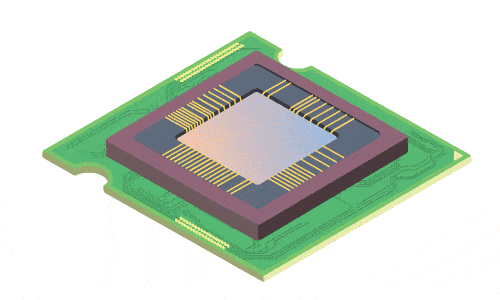
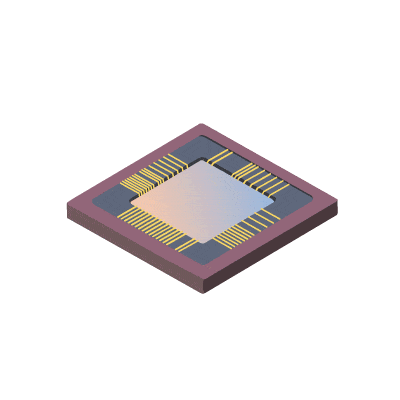
Left: A light pattern is overlayed on the sensor. Any discrepancies in tilt, rotation, and depth will distort the light pattern. These distortions are measured and compensated for by moving the sensor using the 6DoF system (Right). From this, the sensor is tuned to the correct position in real time. Learn more about LUCID’s active sensor alignment process.
Frame Rates and Interface Bandwidth
Depending on the camera’s chosen interface, certain sensors will have different maximum frame rates. To meet the high readout speeds of Pregius S sensors, LUCID’s new Atlas10 comes with a 10 Gigabit interface, with NBASE-T compatibility for fallback to 5/2.5/1 GigE speeds. The Atlas10 features the Sony Pregius S 24.5 MP, 20.4 MP, and 16.2 MP high speed sensors.
The Atlas10 camera combines 10 Gigabit speeds with PoE, paired with Sony Pregius S sensors.

10 GigE is a cost-effective interface offering high bandwidth over twisted pair copper cables.
Something for Everyone
The Pregius family of sensors presents a wide variety of sensors to meet a multitude of imaging requirements. There is a total of 38 sensors designed for industrial applications spanning across 4 Pregius generations. There are 2 frame rate variations (high speed and standard speed), 4 pixel sizes, 12 sensor sizes, 7 aspect ratios, and resolutions ranging from 0.4MP up to 31.4MP. For users looking for enhanced sensitivity, 1st and 3rd generation sensors offer the highest saturation capacity results thanks to their larger pixel sizes. 2nd generation sensors offer the widest variety of resolutions and aspect ratios. 4th generation sensors offer some of the highest resolutions in compact sensor sizes while maintaining overall sensitivity thanks to its backside illuminated 2.74µm pixel. Whichever sensor is chosen, it is important to consider high quality components such as optics and illumination and also which camera manufacturing processes are employed to maximize imaging quality, such as active sensor alignment and quality control testing.

 Support Center
Support Center

